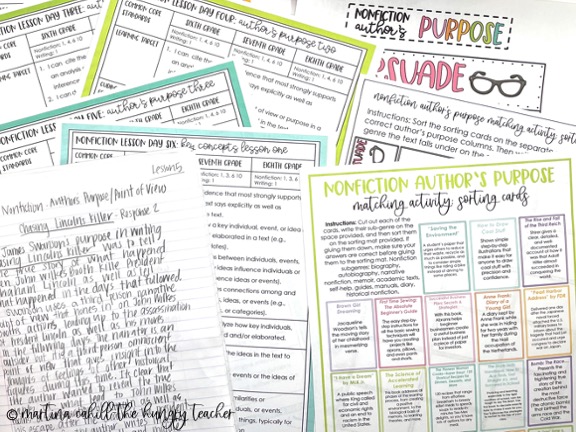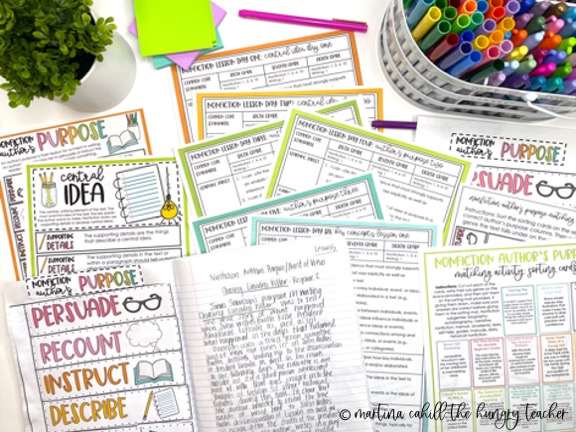hey friend!
I'm Martina.
I provide practical, time-saving strategies that actually work—so you can engage your students, teach effectively, and reclaim your time from the exhausting planning-grading cycle.
Browse Our ELA Resources
Tips for Teaching Author’s Purpose with Nonfiction
Any quick Google search on teaching author’s purpose with nonfiction in middle school will result in lots of PIE related content. As a middle school teacher though, you probably want to take your students beyond the basics of just identifying the author’s purpose.
There was a point in my teaching career where my students knew the different reasons an author might write a story, but they could not apply it to anything. Honestly, I think it’s an easy trap to fall into because author’s purpose is typically just described as PIE…nothing beyond that!
I want to share some resources and tools I now use to help my students dig deep with author’s purpose and analyze the choices an author makes.

What is author’s purpose?
When I teach author’s purpose to my students, I give them the following definition: An author’s purpose is their reason for or intent in writing. An author’s purpose may be to amuse the reader, to persuade the reader, or to inform the reader.
Typically, author’s purpose is described as the reason an author wrote a text, but what student’s struggle to understand is how the author’s choices in their writing contribute to this purpose.
For instance, in a speech, the author may be persuading their audience to take action. How do they do this? They may write in second person to speak directly to their audience, or incorporate extended metaphors to invoke certain emotions. All of these choices were made because the author wants to persuade their audience.

How do you teach author’s purpose with nonfiction?
You have probably talked about author’s purpose already with students, but now your conversations are focused specifically on nonfiction. This is the perfect time to push students beyond PIE.
If you were to stick only with PIE when teaching nonfiction, then we are really only talking about two purposes: an author is persuading or informing. In reality, however, there are many more reasons why an author will write a text.
I use the following author’s purpose mini-lesson to review author’s purpose during my nonfiction unit:
#1: Directly Teach Author’s Purpose
To start, begin by directly teaching students about author’s purpose. Review the author’s purpose concepts you have already taught this year and get a sense of what your students know.
Then, you want to dig deeper into nonfiction. When talking about author’s purpose with nonfiction, give students several verbs: persuade, recount, instruct, describe, explain, and inform. All of these verbs are different reasons an author would write a nonfiction text. Next, go over each of these verbs and give students an example.
For example, I give them the following definition for explain: the author wants to make clear how something works, how something is made, or why something occured. For example, directions on how to build a dollhouse.
Students should take notes in their journals using an interactive notebook page or some other note taking system.

#2: Discuss Subgenres
I’ve noticed in the past that my students felt overwhelmed with all of these new verbs until I helped them connect it to the subgenres in nonfiction. After discussing the different types of author’s purpose, have students turn and talk with their neighbor about the following question: what are different types of nonfiction?
Write down the different types of nonfiction your students come up with, and fill in any gaps. These are the subgenres I always discuss with students: biography, autobiography, narrative nonfiction, memoir, academic texts, self-help, guides, manuals, diary, and historical nonfiction.
Then, have students make connections between author’s purpose and subgenres. For example, a diary or memoir might recount events, and manuals and self-help might instruct. Obviously these are not strict parameters, but it helps students better categorize the different author’s purpose.
#3: Identification Practice
Now that your students have all the information from the author’s purpose mini-lesson, it’s time to apply their knowledge. You can practice identification several different ways:
- Card Sort: On task cards or slips of paper, write the title and description of several nonfiction texts. Have students sort the titles by author’s purpose, and also challenge them to identify the subgenre.
- Previously Read Texts: Compile a list of the nonfiction texts you have read so far in class. Then, have students identity the author’s purpose and subgenre for each.
- Research: Give students the title to several nonfiction texts. Have them look up information about the text, and then identify the author’s purpose and subgenre.

#4: Reading Response
In the next day or two, spend some time reviewing author’s purpose with your students. When you are ready to increase the challenge, give students a reading response task. This can be done with any nonfiction text, and it’s a great way to practice analyzing author’s purpose.
After reading a nonfiction text, have students answer the following questions:
- What is the author’s purpose of the text?
- Why do you think this is the author’s purpose?
- What evidence from the text supports this author’s purpose?
- What is the subgenre of nonfiction?
I love using reader’s response when teaching author’s purpose because it really challenges my students. They have to take all of the knowledge they have of nonfiction and demonstrate that they have a deeper understanding of the concept.
This mini-lesson for author’s purpose is included in the Nonfiction Interactive Notebook Unit for Middle School. This unit has everything you need to explore nonfiction with your middle school students. It includes 24 lesson plans and resources, over 30 reading response examples, reference pages, and digital notebooks.
This unit covers all of the key standards for nonfiction, so your students can master author’s purpose, central idea, text structures, test features, and more! You can check out the entire unit here!

Want a sneak peek at teaching The Hungry Teacher way—with support, structure, and strategy?
When you join the waitlist for The Hungry Teacher’s Hub membership, you get three free classroom-ready resources: a theme unit, an expository writing unit, and a grammar unit introducing mentor sentences. Plus, you’ll get immediate access to a selection of exclusives from the Hub, including editable sub plans, pacing guides, and more.
No strings attached. Just resources you can use right now—and a heads-up when the Hub opens.
3 Free Middle School ELA Units—yours to keep!
JOIN THE WAITLIST + A FREE GIFT
Where to next, line leader?
Welcome to The Hungry Teacher! We create resources that are easy to use, practical, and get results. Teach with confidence—and make it home before dinner.
xo, the hungry teacher